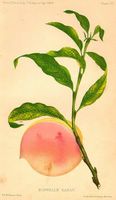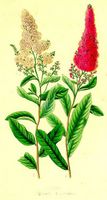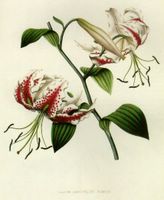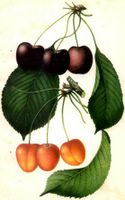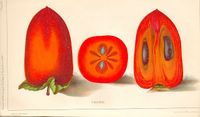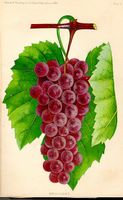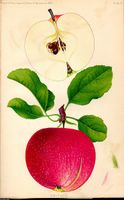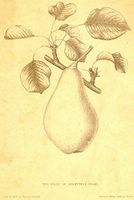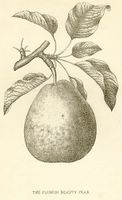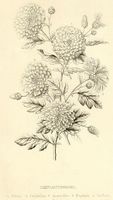Drawings From Nature
William Henry Prestele was a botanical/agricultural/horticultural artist from a family of botanical artists. He contributed to the documentation of fruits and flowers by his lithographic artwork in a time when accurate color reproductions for publications were expensive, difficult, and rare.
He was born in Hessen-Darmstadt, Germany on October 13, 1838. His given name was Wilhelm Heinrich but in American he was known as William Henry. His parents were Franz Joseph Martin Prestele and Karoline Russ. His father, Joseph Prestele, was a renowned lithographer using stone engraving and taught William his craft. Although William did not do stone engraving lithography, he did do watercolors, chromo lithography, and variations of stone lithography. The family was part of a religious group known as the Community of True Inspiration which was later referred to as the Amana Society or Amana Colonies in Iowa. He emigrated with his family to New York in 1843 and lived until approximately 1858 in Ebenezer, New York (near Buffalo). It is now known as Gardenville, NY.Around 1858, when his family moved to the Amana Colonies in Iowa near Homestead Iowa in northeastern Iowa, William left Ebenezer to "live in the world" in New York City where his older brother Joseph Jr had gone. From 1861 to 1863, he fought as a private in Co. E, 26th Regiment of the N.Y. infantry volunteers. He was wounded in the right thigh in the battle of Antietam and served the remainder of his service in a hospital. This wound would bother him greatly the rest of his life. Around approximately 1863, he married an Irish girl named Anne. In 1864, his daughter Margaret was born and he was an artist living on Ninth Avenue in New York. In 1867, he was hired to make a line of nurserymen's plates by Franklin Kelsey Phoenix, owner of the Bloomington [Illinois] Nursery. The nursery was on its way to becoming the 2nd largest in the US. William and his family moved to Bloomington. The plates were printed by firms in the Midwest, i.e. Chicago, Louisville, St. Louis, and Milwaukee. William superintended the limited operations at the nursery, chiefly the preparation of design for the plates, and their coloring after they were printed. No surviving plates with William's confirmed work have been located. Some examples of Phoenix plates are in an assortment bound in 1876 or later, with Bloomington Nursery on the cover. In August 1869, Thomas Meehan, the publisher and editor of the Gardener's Monthly and Horticultural Advertiser (Philadelphia) n.s., vol. 2, no. 8 (August 1869) commented on the Bloomington Nursery's new plates. "We have now before us a fruit piece... prepared by W. H. Prestele. We are in the habit of admiring European art in this line, and have often wished Americans could successfully compete with it. We now have it here. We never saw anything of the kind better executed from any part of the world. We wish the new enterprise every success." Around 1869-1870, his son Frances J. was born. In 1870, William went to Amana to visit his widowed mother. On January 6, an hour after he had left to return to Bloomington, she died. In March 1870, a Bloomington reporter got a tour of the nursery which included the "drawing and coloring department" adjoining the main office, which was "under the supervision of Wm. H. Prestele, of N.Y., an artist of acknowledged talent and a most pleasant gentleman." He employed his brother Joseph Jr, who had moved to Bloomington with his wife and daughter. In 1870, daughter Emma Caroline was born in Bloomington. Around 1871-1872, his wife Anna died either in Bloomington or after the family moved to Coralville, Iowa. In late 1871 or early 1872, the Prestele brothers ended relationship with Phoenix. Joseph Jr. left Bloomington, perhaps to N.Y. William stayed in Bloomington, going into business with L.B. Littlefield, publishing fruit and flower plates. The venture was short lived and William carried on for a short time by himself. In 1872, William produced a mammoth "Showcard" printed in St. Louis. 12 years later, one of these was commemorated to Charles Downing of Newburgh, New York - the horticulturist, author, and brother of Andrew Jackson Downing - for kindness shown. In 1875, William moved the family to Coralville, Iowa, a village near Iowa City not far from the Amana community. He married his second wife, Susanna Gefaller (a native of Baden) who lived in Homestead, one of the Amana Villages. He set up as a lithographer in Iowa City, having acquired a lithographic press, stones, and paraphernalia. In 1878, his daughter Lilly (Lillian) was born. In 1879, he published a catalogue listing 472 titles of plates he had in stock. In 1880, he carried on his business in Johnson County, Iowa for more than a decade. In 1882, his second wife Susanna died at their home in the suburb of Coralville at age 43, (possibly of breast cancer). On August 1, 1887, when he was 49, William was appointed as the first artist on the staff of the newly created Pomological Division of the Department of Agriculture in Washington, D.C. His beginning salary was $1,000 a year (1/3 of the budget of the entire division which had a staff of 3). Each of the pomologist's reports in the Report of the Secretary of Agriculture from 1887 to 1892 include 6 to 8 chromo lithographs of watercolors signed "Wm. H. Prestele fecit". 1893 only had one plate. In 1889, 5 artists were added to the department. In 1891, William got an assignment to make carefully researched watercolors of some 30 species and subspecies of native grapes intended as illustrations for a monograph by T. V. Munson of Denison, Texas, a leading authority on native grapes. The project had taken 6 years to complete. The monograph was never published. The original text has disappeared but the plates are preserved at the United States Department of Agriculture's Research Center, Beltsville, Maryland. In 1894, his salary was $1,200. On May 7, at 56, he completed a watercolor of the "Hartford Prolific" grape which is signed and dated. In Aug 16, 1895, William died in Arlington, VA or Washington, D.C. possibly of a stroke. His son Francis was living in the Washington D. C. area at the time, and his married daughter Emma was also living in the Arlington, VA area at the time. He is buried in Arlington National Cemetery
The chromo lithographs drawn and colored for publishing in the Report of the Secretary of Agriculture, were located in the Report of the Pomologist sections. Approximately 300,000 copies of each book were printed. The actual name of the report changed in the 7 years William was associated with it. Most of William Henry Prestele's artwork was signed and in bold letters.
Description at age 40: height 5' 7", complexion light, hair gray, eyes blue.
Much but not all of the information comes from the following source:
Drawn From Nature: The Botanical Art of Joseph Prestele and His Sons
by Charles van Ravenswaay
Smithsonian Institution Press, Washington, D.C. 1984
ISBN 0-87474-938-7









